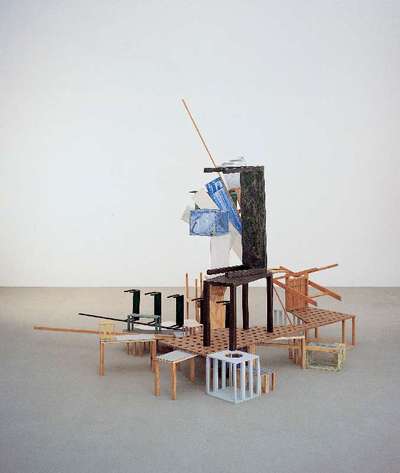Javascript must be enabled to continue!
Painting Lesson No. 5
View through Europeana Collections
Painting Lesson No. 5 is a three-dimensional “painting” that can be viewed from different vantage points, with the floor as its canvas. At the same time, it might be considered a dictionary or catalogue of the modernist languages of sculpture, from Russian Constructivism in the early 20th century to Minimalism in the 1960s. Nahum Tevet creates a distinctive sculptural and conceptual world. Unconventionally, he brings together abstract sculptural language and everyday readymade objects, combining pure art with the craftsmanship of carpenters and painters. He also brings together the ideal of pristine abstract art and the need to relate to the real world and to personal and collective memory. By fusing these forms and ideas, he makes a statement about our ability to perceive and depict the complexity of reality. Tevet, who as a young man studied under the influential Israeli painter Raffi Lavie, has produced an homage to the country’s founding fathers of abstract art. Several hallmarks of this school of painting are echoed in his sculpture, such as the geometric forms and the way in which the color is applied. These features can also be seen in the paintings displayed nearby.
Title: Painting Lesson No. 5
Description:
Painting Lesson No.
5 is a three-dimensional “painting” that can be viewed from different vantage points, with the floor as its canvas.
At the same time, it might be considered a dictionary or catalogue of the modernist languages of sculpture, from Russian Constructivism in the early 20th century to Minimalism in the 1960s.
Nahum Tevet creates a distinctive sculptural and conceptual world.
Unconventionally, he brings together abstract sculptural language and everyday readymade objects, combining pure art with the craftsmanship of carpenters and painters.
He also brings together the ideal of pristine abstract art and the need to relate to the real world and to personal and collective memory.
By fusing these forms and ideas, he makes a statement about our ability to perceive and depict the complexity of reality.
Tevet, who as a young man studied under the influential Israeli painter Raffi Lavie, has produced an homage to the country’s founding fathers of abstract art.
Several hallmarks of this school of painting are echoed in his sculpture, such as the geometric forms and the way in which the color is applied.
These features can also be seen in the paintings displayed nearby.
Related Results
painting, painting, painting, painting, painting, painting, painting, painting, painting, painting, painting, painting, painting, painting, painting, painting, painting, painting, painting, painting, painting, painting, painting, painting, painting, paint
painting, painting, painting, painting, painting, painting, painting, painting, painting, painting, painting, painting, painting, painting, painting, painting, painting, painting, painting, painting, painting, painting, painting, painting, painting, paint
"Here is portrayed three Moods of the Sky and the effects on the Fish and Animals. Sharks and Turtles come to the Surface when it is Raining. Wallabies and Kangaroos are out feedin...
Luminescence
Luminescence
In 1925, at the first exhibition of the OST, the painter I. Kudriashov presented two series of paintings: the Construction of Straight Line Movement and the Construction of Curvili...
Pierrot Content
Pierrot Content
Pierrot content is one of a group of early works by Watteau in which the artist developed the theme of the fête galante that would be so highly appreciated during the 18th century....
Heimdal överlämnar Brisingasmycket till Freja
Heimdal överlämnar Brisingasmycket till Freja
New acquisition, September 2013: Competition entry by Nils Andersson Nils Andersson's painting Heimdal Returns Brisingamen to Freya is an evocative example of the images of ancient...
The Mother of God of Trakai
The Mother of God of Trakai
It is one of the oldest easel paintings in Lithuania, closely linked to Vytautas, the Grand Duke of Lithuania (reigning 1401-1430), and early Christianisation in Lithuania. Up unti...
Colors of Mount Emei (Emeishan se)
Colors of Mount Emei (Emeishan se)
Dong Shouping (1904-1997) painted this short hanging scroll in ink and colors on paper. It depicts Mt. Emei's famous and very colorful sunrise. A mass of rocks--presumably the moun...
The Water Stream, La Brème
The Water Stream, La Brème
“I also hold that painting is a quite concrete art, and can consist of nothing but the representation of real, tangible things, ” wrote Gustave Courbet in an open letter to his stu...




